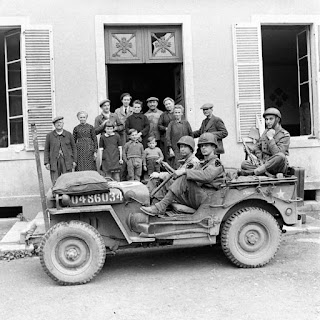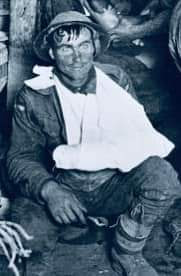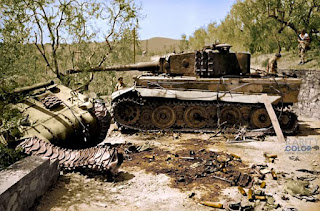March 9, 1945: On the northern side of the western front, Field Marshal Montgomery issues instructions for crossing the Rhine north of the Ruhr.
March 9, 1945: On the northern side of the western front, Field Marshal Montgomery issues instructions for crossing the Rhine north of the Ruhr.
Germans abandon their Wesel bridgehead across the Rhine overnight, and blow the last remaining bridge. Canadian 1st Army mops up around Xanten and captures Veen. US 9th Army continues attacking toward Wesel on its left flank - capturing Ossenberg, Borth, and Wallach - and regrouping for the assault across the Rhine.
Farther south, US 1st Army mops up around Bonn and works to expand the bridgehead across the Rhine at Remagen, where Erpel is captured. Bonn and Godesberg are captured by units of US 1st Army. Even farther south, toward Koblenz, US 3rd Army units reach the Rhine at Andernach, clearing the town.
The German raiding force from the Channel Islands arrives aboard minesweepers, attacks Granville, destroys installations, and releases 67 POWs. They also attack and sink the British vessels Kyle Castle, Nephrite, and Parkwood.
TheNorwegian vessel Heien is also sunk. The German raiding forces capture British vessel Eskwood at Granville and tow it to Jersey in the Channel Islands. US Navy sub chaser PC-564 is damaged by the Kriegsmarine minesweepers and runs aground off Normandy. Kriegsmarine minesweeper M-412 runs aground while returning to Jersey with the Granville raiding force and scuttled.
Over Germany, US 8th Air Force attacks Kassel with 318 bombers, rail yards with 277 bombers, Frankfurt am Main with 410 bombers while US 15th Air Force attacks rail yards and bridges. RAF Bomber Command sends 159 aircraft to attack Datteln during the day and 92 aircraft to attack Berlin overnight.
On the eastern front, German troops launch an offensive toward Striegau, Germany (now Strzegom, Poland). German Army Group South continues its offensive around Lake Balaton with little success and German Army Group E engaged with 3rd Yugoslavian Army along the Drava River. Soviet 2nd Belorussian Front continues assaulting toward Danzig and Soviet 1st Belorussian Front continues attacking toward the Baltic near the mouth of the Oder River.
In Italy, US 5th Army occupies Monte Valbura and Monte Belvedere without opposition while US 12th Air Force aircraft attack transportation lines, supply depots, airfields, and other targets throughout northern Italy, including Mila, Cittadella, Ala, Santa Margherita d'Adige, La Spezia, Ghedi, and Lecco.
On Iwo Jima, US V Amphibious Corps succeeds in splitting the remaining Japanese defenses into two separate pockets as 3rd Marine Division breaks through to the coast in corps center, splitting enemy forces remaining on the island.
Following a one-man assault on enemy-occupied trenches and fortified positions, Platoon Sergeant Joseph Rudolph Julian is killed in action. He is awarded the Medal of Honor posthumously for heroism above and beyond the call of duty. Here is his citation:
“Determined to force a breakthrough when Japanese troops occupying trenches and fortified positions on the left front laid down a terrific machinegun and mortar barrage in a desperate effort to halt his company's advance, P/Sgt. Julian quickly established his platoon's guns in strategic supporting positions, and then, acting on his own initiative, fearlessly moved forward to execute a 1-man assault on the nearest pillbox.
Advancing alone, he hurled deadly demolition and white phosphorus grenades into the emplacement, killing 2 of the enemy and driving the remaining 5 out into the adjoining trench system. Seizing a discarded rifle, he jumped into the trench and dispatched the 5 before they could make an escape. Intent on wiping out all resistance, he obtained more explosives and, accompanied by another Marine, again charged the hostile fortifications and knocked out 2 more cave positions.
Immediately thereafter, he launched a bazooka attack unassisted, firing 4 rounds into the 1 remaining pillbox and completely destroying it before he fell, mortally wounded by a vicious burst of enemy fire. Stouthearted and indomitable, P/Sgt. Julian consistently disregarded all personal danger and, by his bold decision, daring tactics, and relentless fighting spirit during a critical phase of the battle, contributed materially to the continued advance of his company and to the success of his division's operations in the sustained drive toward the conquest of this fiercely defended outpost of the Japanese Empire.
His outstanding valor and unfaltering spirit of self-sacrifice throughout the bitter conflict sustained and enhanced the highest traditions of the U.S. Naval Service. He gallantly gave his life for his country.”
Pictured: A .50-caliber machine gunner keeps a BAR handy at Remagen on March 9, 1945.; The finished treadway bridge at Ehrang. The bridge was inspected by General Walton B. Walker, Commander of the XX Corps, Third Army on March 9, 1945.; 63AIB troops and tanks attacking sniper positions in Andernach, Germany, March 9, 1945.; Grave marker for Medal of Honor recipient Joseph Rudolph Julian.














Comments
Post a Comment